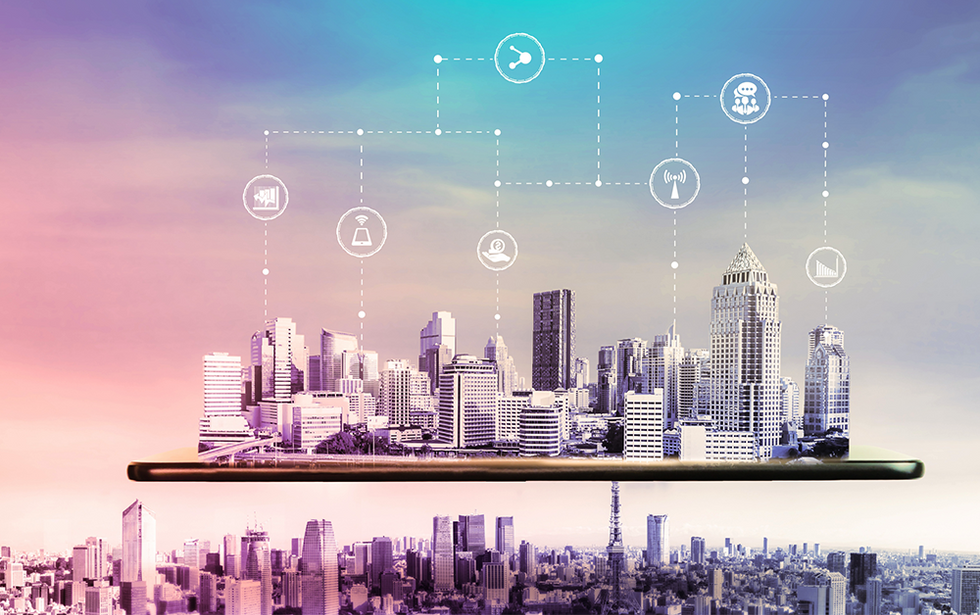Cities are now advancing past the pilot stage and becoming smart cities. They are also utilizing data and digital technology to give residents results more pertinent and significant. Recently, city officials viewed smart technologies as a means of improving administrative efficiency. The lives of the locals are now increasingly affected by technology. Millions of people now have fast access to information about public transportation, traffic, health services, emergency alerts, and local news thanks to smartphones.
What makes a smart city 'smart'?
In order to make better decisions and enhance the quality of life, smart cities use data and digital technologies. Agencies are able to follow events as they develop, comprehend how demand patterns are evolving, and respond with quicker and more affordable solutions thanks to more complete, real-time data.
A smart city operates on the basis of three layers. The first is the technological foundation, which consists of a necessary number of cellphones and sensors linked by quick communication networks. The second layer of applications is present. The correct tools are needed to convert raw data into alerts, insight, and action, and here is where technology providers and app developers come in. Use by businesses, cities, and the general public makes up the third layer.
Smart Cities in Japan: The major growing country
As more businesses join the Smart City Institute Japan, a non-profit organization that links the sectors involved in creating smart cities in Japan, the number of smart cities in the country is gradually growing throughout various prefectures. Japan's national vision is for a Society 5.0—a data-driven, human-centered, next-generation society using AI, big data, and IoT—that will use such technologies to deliver appropriate solutions.
Smart towns like Kashiwa-no-ha and Fujisawa are encouraging other investors from Japan and the rest of the globe to realize why it is crucial to construct a smarter future by demonstrating core outcomes of how smart is the way forward. According to Astute Analytica, the global Japan Emerging Technologies in Smart Cities Market will grow at a CAGR of 14.7% from 2022 to 2030.
Emerging Technologies making Smart Cities "Smart."
Internet of Things (IoT)
Municipalities are starting to invest in this industry as they become more aware of the benefits of a smart city. In order to evaluate the data and gain useful information to improve urban services, sustainability, safety, mobility, and transparency of the city, they can collect data from sensors, linked devices, and intelligent networks thanks to the Internet of Things.
The three key areas where IoT is having an impact in cities are transportation and urban mobility, energy, and urban maintenance.
For the purpose of facilitating residents' mobility and assisting them in finding parking for their personal automobiles, it offers information about traffic and parking locations in the area of transportation and urban mobility.
By connecting, for instance, street lights to an intelligent network that enables them to adapt their lighting to the needs of the time, towns can lower their electricity costs and boost energy efficiency.
With strict oversight of urban furniture and garbage management, administrations can improve the condition of the city through urban maintenance.
Artificial Intelligence
Smart cities benefit greatly from AI, which is becoming more prevalent in these cities. Smart cities will power by smart meters for public energy, water, and gas sources, as well as monitoring equipment enhanced with artificial intelligence.
One of this technology's primary uses and one of its key advantages is preventive maintenance. Municipalities can now detect water leaks and stop issues sooner to resolve them more rapidly thanks to AI.
Another use of AI in smart cities is to manage traffic and increase road safety for inhabitants. Additionally, more and more security cameras with AI power exist for purposes other than simple video surveillance. They are cameras that can recognize a license plate in order to manage access to the city and keep polluting vehicles out.
Blockchain
The world is about to transform due to blockchain technology, and more and more towns are placing bets on it.
Cities' major current challenges—participation, transparency, sustainability, competitiveness, corruption, and fraud—would be overcome thanks to blockchain technology. The proponents of this research contend that a secure, open, and unchangeable system like Blockchain is necessary.
Undoubtedly, there is a lot of room for expansion in this technology. Technology that enhances urban government and provides services to cities. Transparency and security are crucial since these services demand a high frequency of records and documentation and include numerous different operations.
You may use Blockchain to create an impartial, safe, and accessible information base to fight corruption and create the required transparency in government operations.
Estonia is one country where the government uses blockchain technology. E-Residency is one of the most notable programs the Estonian government has supported with this technology. People can establish their identity or create a business in Estonia using this type of digital ID from anywhere around the globe. Estonia has maximized effectiveness and reduced inefficiency as a result of this approach.
Geospatial Technology
Geospatial technology is used in smart cities to either identify ecologically harmful disasters or to make urban areas more accessible and environmentally pleasant. This technology responds to citizen demands by, among other things, providing solutions in areas like transportation, power plants, water supply networks, civil protection, and public facilities.
In addition to the geospatial information management, climate and environmental monitoring in cities allow for the detection of environmental changes, improving prevention, accelerating response to extreme weather events and natural disasters, and enhancing decision-making.
In this way, technology aids public administrations in establishing towns that are more devoted to the environment through improved environmental management of their cities.

















